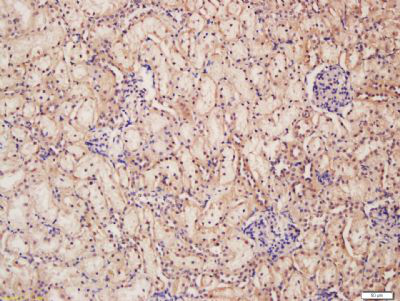产品货号 : mlR6753
英文名称 : WWP1
中文名称 : WW结构域E3泛素连接酶1抗体
别 名 : AIP 5; AIP5; Atropin-1-interacting protein 5; hSDRP1; nedd4 like; NEDD4-like E3 ubiquitin-protein ligase WWP1; Tiul1; WW domain containing E3 ubiquitin protein ligase 1; WW domain-containing protein 1; WWP 1; WWP1_HUMAN.
研究领域 : 肿瘤 细胞生物 信号转导 肿瘤细胞生物标志物
抗体来源 : Rabbit
克隆类型 : Polyclonal
交叉反应 : Human, Mouse, Rat, Dog, Cow, Horse, Rabbit, Sheep,
产品应用 : ELISA=1:500-1000 IHC-P=1:400-800 IHC-F=1:400-800 IF=1:100-500 (石蜡切片需做抗原修复)
not yet tested in other applications.
optimal dilutions/concentrations should be determined by the end user.
分 子 量 : 105kDa
细胞定位 : 细胞核 细胞浆 细胞膜
性 状 : Lyophilized or Liquid
浓 度 : 1mg/ml
免 疫 原 : KLH conjugated synthetic peptide derived from human WWP1:21-120/922
亚 型 : IgG
纯化方法 : affinity purified by Protein A
储 存 液 : 0.01M TBS(pH7.4) with 1% BSA, 0.03% Proclin300 and 50% Glycerol.
保存条件 : Store at -20 °C for one year. Avoid repeated freeze/thaw cycles. The lyophilized antibody is stable at room temperature for at least one month and for greater than a year when kept at -20°C. When reconstituted in sterile pH 7.4 0.01M PBS or diluent of antibody the antibody is stable for at least two weeks at 2-4 °C.
PubMed : PubMed
产品介绍background:
WWP1 is an E3 ubiquitin ligase and belongs to a family of NEDD4-like proteins. WWP1 contains 4 tandem WW domains and a HECT (homologous to the E6-associated protein carboxyl terminus) domain. WW domain-containing proteins are found in all eukaryotes and play an important role in the regulation of a wide variety of cellular functions such as protein degradation, transcription, and RNA splicing. The HECT domain of WWP1 has been implicated in regulating the localization and stability of p53 – inhibition of WWP1 results in a decrease in p53 expression, whilst WWP1 mediated stabilization of p53 appears to be associated with an accumulation of cytoplasmic p53. WWP1 also negatively regulates the TGF beta tumor suppressor pathway by inactivating its molecular components (SMAD2, SMAD4 and TGFbetaR1). WWP1 has been implicated in both breast and prostate cancers.
Function:
E3 ubiquitin-protein ligase which accepts ubiquitin from an E2 ubiquitin-conjugating enzyme in the form of a thioester and then directly transfers the ubiquitin to targeted substrates. Ubiquitinates ERBB4 isoforms JM-A CYT-1 and JM-B CYT-1, KLF2, KLF5 and TP63 and promotes their proteasomal degradation. Ubiquitinates RNF11 without targeting it for degradation. Ubiquitinates and promotes degradation of TGFBR1; the ubiquitination is enhanced by SMAD7. Ubiquitinates SMAD6 and SMAD7. Ubiquitinates and promotes degradation of SMAD2 in response to TGF-beta signaling, which requires interaction with TGIF.
Subunit:
Binds KLF2 AND HIVEP3. Binds SCNN1A, SCNN1B, SCNN1G, WBP1, WBP2, DRPLA and adenovirus type 2 PIII. Interacts with RNF11. Interacts with SPG20. Interacts with ERBB4 isoforms JM-B CYT-1 and JM-A CYT-1. Interacts with SMAD1, SMAD2, SMAD3, SMAD5, SMAD6, SMAD7, TGFBR1 AND TGFBR2. Associates with the TGFBR1:TGFBR2 receptor complex in presence of SMAD7. Interacts with SKIL isoform 1. Interacts with TP63 isoform 1 and isoform 2. Interacts with STAMBP and RNF11. Interacts with NDFIP1 and NDFIP2 (Probable); this interaction activates the E3 ubiquitin-protein ligase. Interacts with TGIF.
Subcellular Location:
Cytoplasm. Cell membrane; Peripheral membrane protein. Nucleus.
Tissue Specificity:
Detected in heart, placenta, pancreas, kidney, liver, skeletal muscle, bone marrow, fetal brain, and at much lower levels in adult brain and lung. Isoform 1 and isoform 5 predominate in all tissues tested, except in testis and bone marrow, where isoform 5 is expressed at much higher levels than isoform 1.
Post-translational modifications:
Auto-ubiquitinated and ubiquitinated by RNF11.
Similarity:
Contains 1 C2 domain.
Contains 1 HECT (E6AP-type E3 ubiquitin-protein ligase) domain.
Contains 4 WW domains.
SWISS:
Q9H0M0
Gene ID:
11059
Important Note:
This product as supplied is intended for research use only, not for use in human, therapeutic or diagnostic applications.
产品图片












